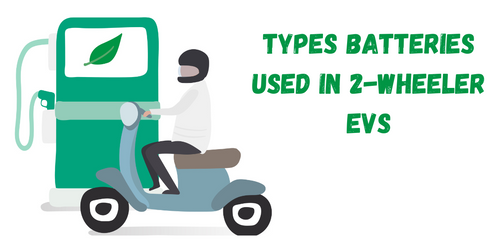Electric Two-Wheelers: A guide to the different battery options.

8960 Views
Get the lowdown on the different types of batteries used in two-wheeler EVs. From pros to cons to knowing what makes each battery unique.

Electric two wheelers have completely changed the dynamics of commuting. But, you’ll have to plan your commutes a day ahead so you don't run out of battery to run your vehicle. Yet EVs manage to cheer you up when you feel your pockets heavy.
If you want to know how much money an EV saves you and what are the practical advantages click here to find out.
But, how much do you know about the only thing that runs it? The Battery.
The battery is the heart of your electric two-wheeler, and it can make or break your experience. Different batteries have different strengths and weaknesses, and they affect how far and how quickly you can commute.
In this article, we’ll explore some of the common battery types used in electric two-wheelers, and help you select the best one for your daily needs.
Lithium-ion Batteries
Lithium-ion batteries are the most common type used in electric two-wheelers today. They composed with new technology that are comparatively denser in nature. They consist of positively charged lithium ions that move from the anode to the cathode through a liquid electrolyte, providing the required charge.
Let me make it simple for you to understand-Imagine a battery as a sandwich with two slices of bread and some filling. The bread slices are the anode and the cathode, which are the parts that connect to the device that needs power. The filling is the electrolyte, which is a liquid that lets the electricity flow. The electricity is made by tiny particles called lithium ions, that move from one slice of bread to the other through the filling, and this gives energy to the vehicle.
Pros:
They are light and compact, which improves the efficiency and range of the electric two-wheeler.
They have a high energy density, as they store more energy per unit weight or volume, than other types of batteries.
They have a low self-discharge rate, and retain their charge for longer periods when not in use.
They have a high depth of discharge, as they can be fully drained without affecting their lifespan.
They are recyclable and (obviously) environment friendly.
Cons:
They are expensive to produce and purchase, which increases the initial cost of the electric two-wheeler.
They require sophisticated management systems to prevent overcharging, overheating and short-circuiting, which can cause fire or explosion risks.
They have a limited number of life cycles, degrading over time and need to be replaced more frequently than other types of batteries.
Some examples of electric two-wheelers that use lithium-ion batteries are Ola S1 Pro, Ather 450X and TVS iQube.
LFP Batteries
LFP stands for lithium ferro phosphate, which is a type of lithium-ion battery, that uses iron phosphate as the cathode material instead of the more common cobalt oxide or nickel manganese cobalt oxide.
In simple terms- Remember the battery sandwich? The filling is the same, but the bread is different. Instead of using regular bread, this battery uses a special bread made with iron and phosphate. This bread is cheaper, safer and lasts longer than the regular bread.
Pros:
They are safer and more stable than other types of lithium-ion batteries, as they do not catch fire or explode even when punctured or damaged.
They have a longer life cycles than other types of lithium-ion batteries, as they do not degrade as fast or lose their capacity over time.
They are cheaper than the lithium-ion batteries, as they do not use scarce or toxic materials like cobalt or nickel.
Cons:
They have a lower energy density than other types of lithium-ion batteries, which means they store less energy per unit weight or volume.
They have a lower voltage output than other types of lithium-ion batteries, which means they need more cells to achieve the same power level.
They have a lower operating temperature range than other types of lithium-ion batteries, as they perform poorly in extreme hot or cold conditions.
Some examples of electric two-wheelers that use LFP batteries are Okaya Faast F4 and Simple Energy One.
Lead Acid Batteries
Lead acid batteries are the oldest type of rechargeable batteries and were widely used in electric two-wheelers when they first entered the market. They are made of a negative porous lead electrode and a positive lead oxide electrode immersed in a dilute sulfuric acid solution.
Just like the above sandwiches, this battery has different ingredients, too. The bread is made of lead, which is a heavy metal. One slice of bread has some oxygen in it, which makes it red. The other slice of bread is gray. The filling is a liquid that has some sulfur and acid in it, which makes it sour and corrosive. The lead and the acid react with each other and create electricity.
Sure, I can help you with that. Here are some pros and cons of lead acid batteries based on the information I found on the web.
Pros:
Low-cost and simple manufacture.
High specific power, capable of high discharge currents.
Good performance at low and high temperatures.
- No block-wise or cell-wise BMS required.
Efficient recycling.
Low self-discharge.
Cons:
Low specific energy; poor weight-to-energy ratio.
Slow charging: Fully saturated charge takes 14–16 hours.
Limited cycle life; repeated deep-cycling reduces battery life.
Adverse environmental impact.
Some examples of electric two-wheelers that use lead acid batteries are Avon E-Bike and Hero Electric Flash.
Nickel Metal Hydride Batteries
Nickel metal hydride batteries are a kind of batteries that can be charged and used again. They are sometimes used in electric bikes or scooters. They have two parts that store and release electricity, one made of a metal called nickel and another made of a compound of nickel, oxygen and hydrogen. They also have a liquid that helps the electricity flow between the two parts, which is made of potassium and water.
Pros
They have a higher energy density than lead acid batteries, and store more energy per unit weight or volume.
They have a lower self-discharge rate than lead acid batteries, as they retain their charge for longer periods when not in use.
They have a higher depth of discharge than lead acid batteries, and can be fully drained without affecting their lifespan.
They have a lower risk of leaking and exploding than lead acid batteries.
Cons
They are heavier and bulkier than lithium-ion batteries, which reduces the efficiency and range of the electric two-wheeler.
They are slower to charge and discharge than lithium-ion batteries, which affects the performance and convenience of the electric two-wheeler.
They suffer from memory effects, which means they lose their capacity if they are not fully discharged before recharging.
They are more expensive than lead acid batteries, but less expensive than lithium-ion batteries.
Some examples of electric two-wheelers that use nickel metal hydride batteries are Hero Electric Optima Plus and Yo Electron ER.
Solid State Batteries
Solid state batteries are a new kind of batteries that are being studied to make the existing batteries better. They have three parts that store and transfer electricity, all of which are solid materials. The current batteries have one part that is solid and two parts that are liquid or jelly-like.
Pros
They have a higher energy density than lithium-ion batteries that can store more energy per unit weight or volume.
They have a lower self-discharge rate than lithium-ion batteries.
They have a higher depth of discharge than lithium-ion batteries, as they can be fully drained without affecting their lifespan.
They have a higher power output than lithium-ion batteries, and can deliver more power to the motor.
They have a lower risk of overheating and short-circuiting than lithium-ion batteries, which reduces the chances of fire or explosion hazards.
They have a longer number of life cycles than lithium-ion batteries and need to be replaced less frequently.
Cons
They are difficult and expensive to manufacture and scale up, increasing the initial cost of the electric two-wheeler.
They require high temperatures to operate efficiently, which affects the performance and safety of the electric two-wheeler.
They are not widely available or tested in the market yet and may face technical and regulatory hurdles.
Some examples of electric two-wheelers that are expected to use solid state batteries in the future are Bajaj Chetak and Revolt RV300.
Conclusion
As you have learned, finding the ideal battery for your electric ride is a complex decision, and you need to balance the strengths and weaknesses of each option.
But don’t fret, there is a battery that matches your preferences, whether you care about speed, distance, price, ease or eco-friendliness. And with the constant innovations in battery technology, we can anticipate more amazing electric two-wheelers on the streets soon.